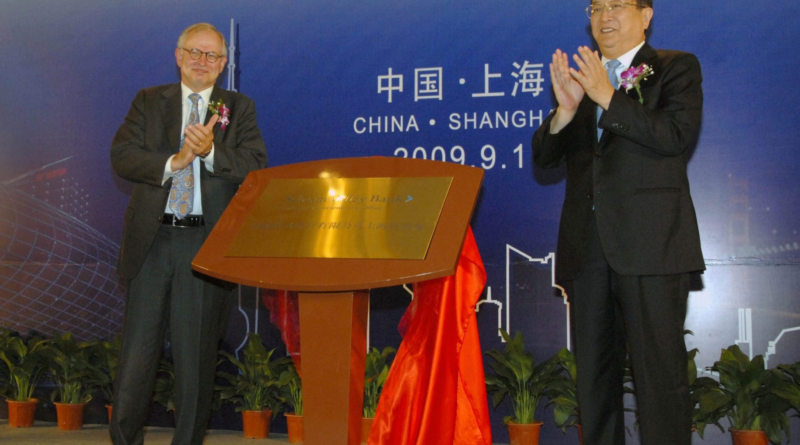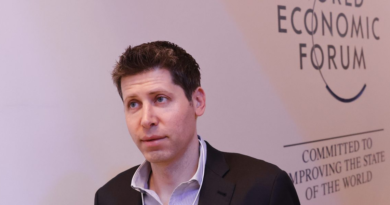How the Communist Party quietly took over SVB’s China operation, according to a former CEO
Everyone knows about Silicon Valley Bank’s (SVB) infamous collapse, but few know the man who helped build the bank’s foundation: Ken Wilcox.
Wilcox made his name by pushing a tech-focused strategy that ushered in an era of rapid growth at SVB Financial Group, the parent of the now-infamous SVB. He spent more than 30 years at the bank in total, including a decade as CEO beginning in 2001, and he isn’t too thrilled with his successors after its failure.
Still, Wilcox remains humble when discussing SVB’s issues, largely because he has experienced his own trials and tribulations. The veteran banker’s latest book—The China Business Conundrum: Ensure That “Win-Win” Doesn’t Mean Western Companies Lose Twice—details lessons learned and mistakes made in the years after he left the helm of SVB to his successor, Gregory Becker.
Wilcox focused on expanding SVB’s business model abroad after stepping down from his CEO role in 2011, heading to China to start SPD Silicon Valley Bank, a joint venture between Shanghai Pudong Development Bank and SVB Financial Group, colloquially known as SSVB.
He served as president and vice chairman of SSVB during his time in China, but things didn’t exactly go as planned, as his latest book’s title suggests. However, unlike its U.S. parent company, SSVB didn’t collapse due to mismanagement and a lack of proper regulatory oversight. Instead, it was taken over by the Chinese Communist Party (CCP)—and it happened, as they say, slowly at first, then all at once.
The Chinese Embassy in the U.S. and the Chinese government didn’t respond to requests for comment.
How SVB first came to China and how its plans unraveled
SVB first went to China in 2000, when Wilcox was still just a chief banking officer at the company. Initially, the Silicon Valley tech-lending powerhouse focused on simply setting up meetings with any venture capitalist or startup founder they could find, hoping to build a startup community that would, eventually, become clients.
“The venture capitalists seemed so Western in their orientation, and so it seemed as if there was something happening there that was going to be very vibrant in the fullness of time,” Wilcox said, recalling his optimism at the time.
By 2004, SVB was organizing tours for venture capitalists from Silicon Valley to see the “embryonic innovation centers” that were growing in China at the time. “We signed up really a class A list of venture capitalists. You name somebody you think was famous back then in the venture capital community—they were doubtless on our trip,” he said.
Three years later, in 2007, SVB was finally able to set up an office in China, but right from the start, something was off. “It wasn’t able to do any business because it had no licenses,” Wilcox recalled. “So we were basically in the business of meeting people.”
Due to the strict regulations that exist surrounding bank permits in China, SVB’s only real money-maker in the country at the time was renting out office space to U.S. venture capitalists who were coming to visit Chinese startups. It had become a glorified WeWork, Wilcox noted.
The turning point
Two years later, SVB got its big break—or at least what seemed like a big break at the time.
At a 2009 event with American and Chinese business leaders on a luxury cruise down the Huangpu river, which intersects Shanghai, Wilcox met a critical contact that would help him establish SSVB. He didn’t realize at the time that this would also be the person—whose name has been altered in Wilcox’s book—that would eventually lead the bank and its business model into the hands of CCP.
“I remember very clearly, we got onto the boat, and this guy who seemed as big as a bear lumbered up to me and immediately shook my hand. Then he grabbed me and gave me a big hug, which was shocking, because Chinese people typically don’t hug,” he remembered. “And from then on, anytime I got together with that guy, he gave me a huge hug, and it turned out he became my ‘best friend’ [in China].”
Wilcox would later learn why his new friend was so, well, friendly. He was the CCP’s secretary for the Yangpu district of Shanghai, and he was hoping to turn his mostly manufacturing-based district into a more high-flying knowledge-based industries district.
“He felt that in order to do that, he needed the secret sauce, and that we had it. And so he was dead set on getting us involved,” Wilcox said.
Seeing a potential ally inside China, Wilcox and some of SVB’s senior leadership went on to meet with CCP officials from the Yangpu district for about a year after they were told that if they explained their business model sufficiently, these regional officials could convince relevant CCP leaders in Beijing that they should be allowed to start a joint venture with SVB, one that included a Chinese tech-focused bank.
“We were willing to do it—to what we hoped would be a minimal extent, just enough that we could get the license,” Wilcox writes of this period in his book.
This was Wilcox’s first brush with what he would later learn is a core tenet of doing business in China: Guanxi. The term is a way of saying mutually beneficial business relationships. But these business ties are often mistaken for friendships by Westerners, and frequently turn one-sided in favor of the CCP absent sufficient leverage.
Without connections, especially to the CCP, doing business in China simply isn’t possible, Wilcox claims, noting SVB certainly wasn’t able to get any banking licenses without CCP contacts.
“Bear in mind, at that point in time, I did not understand Guanxi. I did not understand that it was all about mutual benefit. And actually, when they say mutual, it may even mean theirs,” he explained, admitting: “I didn’t realize that he was going to cheat us to the extent that he did.”
Not long after SVB’s meetings with CCP officials, Wilcox found out that his supposed best friend was starting a competitor, using his business model.
“I heard it through the grapevine, that his little CFO in the Yangpu district left his team and joined a bank called the Shanghai Rural Commercial Bank, and set up a technology lending division using our business model. And then I realized something was fishy here—he is being disingenuous,” Wilcox said.
It didn’t take long for Wilcox to get confirmation that his “best friend” was not what he seemed.
In late 2009, as SVB’s business model was being harvested by the CCP, and partially implemented by some Chinese banks, Wilcox—then SVB’s CEO—was called to a celebration at the Crowne Plaza, a five-star hotel in the Yangpu district of Shanghai by his best friend.
“It was urgent, I had to come,” he explained. “So I get a plane, fly over, and I go to the hotel. There’s a huge meeting room with like 200 government officials in it, and it turns out they’re giving—what was it they called it—innovation advisor awards. And I was dragged up on stage with some guy from Siemens and about five or six other people and awarded an innovation advisor award.”
“And then I put two and two together,” Wilcox added, reflecting on the experience. “This was their way of making me feel good about the fact they’d just stolen my business model.”
After spending many years in China, and absorbing some of both the language and the culture, Wilcox developed an interesting nickname for his “innovation advisor award”—one that exemplifies the experiences of many western businesses in China. To understand it, you just have to know that when a man wears a green hat in China, it’s a symbol that his wife is having an affair.
“I have dubbed it the ‘Green Hat award,’ because it was like they were having an affair with my wife, and they were giving me a reward for having picked her in the first place,” Wilcox said with a wry laugh that would probably send shivers down the spines of many U.S. executives with businesses in China.
You’d think after an experience like that you might think twice about continuing your venture in China, but Wilcox pushed forward. By 2011, as he was nearing retirement, Wilcox still decided he wanted to take on one more challenge. He went to China to lead SVB’s new joint venture, SSVB, fearing that Western competitors or new Chinese copycats might be willing to serve their clients and overtake their tech-lending niche in the country.
The end result wasn’t pretty.
Lessons learned from deception in China
After being deceived by his “best friend,” Wilcox says he operated very differently in China. He came to understand that leverage rules in the country, and for the CCP, contracts are only relevant if the counterparty can enforce them. He learned that there is “no meaningful difference” between private and state-owned companies, only a minor legal distinction. And perhaps most importantly, to “always question the motives of others.”
“They’re not interested in watching you make money, they have a goal of their own, and the goal is typically learning something. It’s either learning your business model or appropriating your technology,” he said.
Unfortunately, this knowledge still didn’t prevent an SSVB takeover. SVB never agreed to share any of its intellectual property, and Wilcox was determined to turn SSVB into a profitable, independent Chinese success—but no matter what he did, there was a steady brain drain.
In his new book, Wilcox describes a few key events that paint a picture of his experience. There was one point when the president of Shanghai Pudong Development Bank and chairman of SSVB at the time called Wilcox in for a meeting only to berate him for not having shared SVB’s proprietary algorithm for determining the best loan candidates. The only problem was there was no algorithm. The exec was on what Wilcox called a “fishing expedition” to find information to share with the CCP or use for himself—and it was one of many.
In between tips like—“if you’re doing something meaningful, your driver will be a low level spy,” “your apartment will be egregiously expensive, and it may well be bugged,” and “you will need two interpreters, one to tell you what people said and the other to tell you what they meant,”—Wilcox recounts more stories of what seems to be a clear takeover by the CCP in China in his book.
The veteran banker was eventually informed by his Chinese partners that the CCP would be setting up something called a “Party Committee” to oversee SSVB—and it wasn’t up for debate. The supposed task of this board was to study recent CCP pronouncements and how they should be applied. But Wilcox was informed in private that it was really a “secret board behind the real board” made of CCP officials, and he wouldn’t be allowed to know the identity of its members.
Over the next few years, Wilcox managed to get a banking license and do some small deals, before leaving SSVB at the end of 2014. It was a short, volatile time in China as president of the JV, and to be honest, it seemed to largely be a mess. Wilcox’s attempt to develop a competitive SVB clone in China was hardly effective.
SSVB is now called Shanghai Innovation Bank. It’s a wholly-owned unit of Shanghai Pudong Development Bank—which is owned by the Shanghai Municipal Government of the Chinese Communist Party. The bank didn’t respond to a request for comment.
But Wilcox remains defiantly optimistic. Even after losing his business model, Wilcox still thinks U.S. businesses can’t avoid the country.
Navigating a fraught landscape: Can U.S. firms thrive in China?
Despite Chinese-U.S. business tensions, Wilcox argued the two countries can’t “decouple” economically as many have claimed. China will always be a critical trade partner, and it will always present an opportunity for American businesses seeking new markets.
Industries that have defense-critical or advanced technologies should be particularly careful about entering China, and may even want to avoid it altogether, according to Wilcox, but many U.S. companies can still have success in the country.
They should try not to give away any proprietary technology or allow their business model to be co-opted, he said, but they should also realize that’s not always possible. If you want to make money in China, you might have to give something away.
“Realize that there is a time frame [for success in China]. It won’t last forever,” he said. “It’s all about not giving up too much without getting something in return.”
Finally, Wilcox emphasized that none of the issues he had with SSVB in China are unique, and any business that goes to the country should go “eyes wide open,” instead of ignoring lessons from past CEOs.
“Many CEOs have figured out the same stuff I figured out, but they are reluctant to talk about it because they don’t want to admit that they got duped,” he said. “I’m not the only person who knows this stuff in the book by any stretch, I’m just one of the few people that feels comfortable talking about it.”



